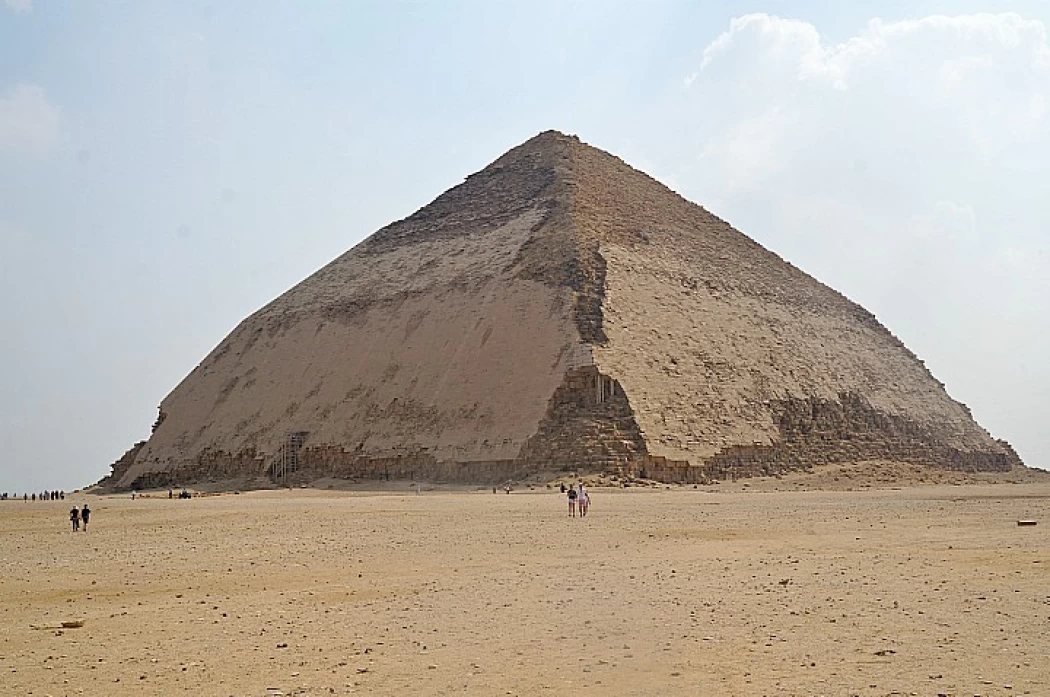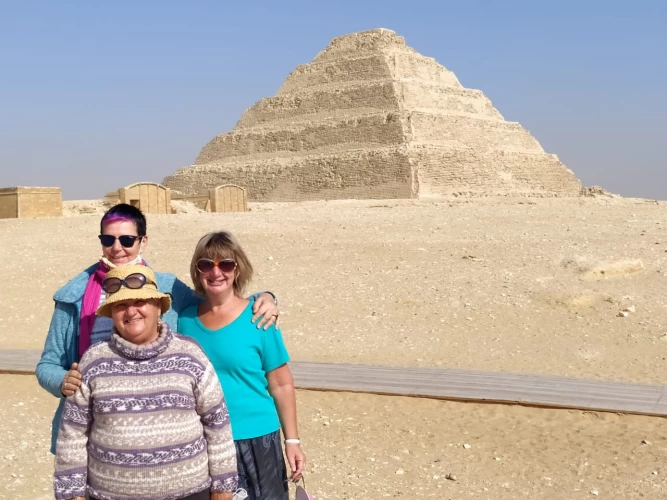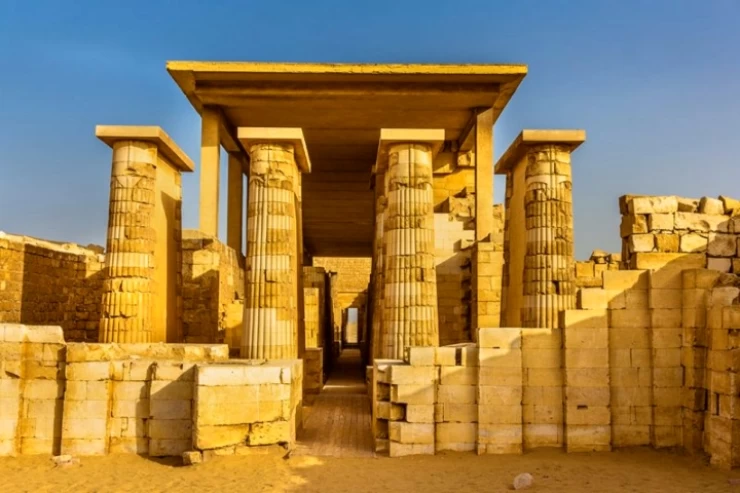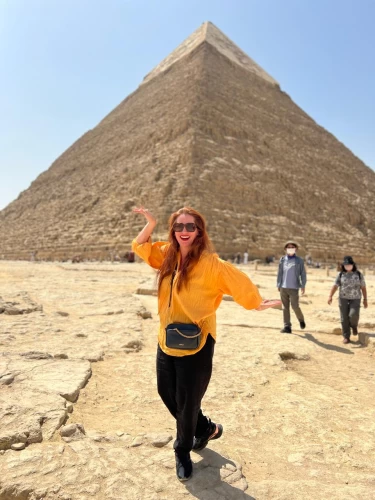
Site archéologique de Dahshur
Site archéologique de Dahshur, Pyramides de Dahchour
En raison de ses nombreux et magnifiques monuments pharaoniques, "Dahchour" est l'une des destinations touristiques qui attirent les touristes du monde entier. Pour se construire une tombe semblable à celle de son père, le pharaon "Zoser", propriétaire de la pyramide de Saqqara, le pharaon égyptien "Senefru" a choisi le plateau rocheux de Dahchour. Dahshur est situé à environ 40 kilomètres au Sud-Ouest du Caire et c'est l'une des choses à faire au Caire qui n'est pas fortement pressurisée par les visites régulières d'une journée au Caire, à l'extrémité Sud du vaste champ de pyramides qui commence à Gizeh. Les fouilles à Dahshur nous ont montré les restes de sept pyramides, ainsi que les complexes de tombes construites pour les reines et la noblesse de Memphis jusqu'à la 13e dynastie dans l'Empire du Milieu.
Les deux dernières pyramides construites à Dahchour ont finalement été détruites par les ravages du temps, comme la Pyramide Noire (XIIe dynastie), qui est gravement endommagée. Dahchour est la patrie de deux des pyramides les mieux préservées d'Égypte. Les deux construits sous le règne du roi Sneferu, fondateur de la 4e dynastie, la pyramide pliée et la pyramide rouge de Dahchour sont considérées comme des preuves massives du développement architectural qui a finalement conduit à la construction de la grande pyramide du roi Khéops et des pyramides, de ses courts successeurs à Gizeh.
La pyramide courbée est la première des pyramides de Dahchour à être construite sous le roi Sneferu, c'était la première tentative de l'Égypte ancienne à une pyramide à côtés lisses. Mais des erreurs de calcul dans la distribution des roches coupées se sont produites provoquant l'angle de la pyramide non pour avoir raison, et c'est pourquoi on l'appelle «La pyramide pliée», cette pyramide n'a jamais été utilisée par le roi qui a tout de suite lancé un autre plan ambitieux. Lorsque vous visitez Dahshur, vous ne passerez pas seulement votre temps à prendre des photos, les touristes auront accès aux deux sépultures restantes du roi Senfru, à la pyramide rouge et à la pyramide courbée.
Le roi Sneferu a ordonné la construction de la deuxième pyramide de Dahchour, la pyramide rouge apprenant de ses erreurs. Une fois achevée, la pyramide était considérée comme un succès. Car il s'agissait d'un bâtiment entièrement construit, à parois lisses, s'élevant à une hauteur (104 mètres). Le nom de la Pyramide Rouge vient de son calcaire rouge. On pense que c'est le lieu de repos du roi Sneferu. Immédiatement après la mort du roi Sneferu, la troisième pyramide de son fils Khufutowas a été fabriquée par son propre héritage, construit pour nous La Grande Pyramide de Gizeh, l’une des sept merveilles du monde.
Plusieurs tombes de femmes royales ont été trouvées, situées près de la pyramide de la 12e dynastie contenant une grande quantité de bijoux (l'étape la plus élevée de la métallurgie en Égypte pendant cette période). La pyramide de Senusret III avec de plus petites pyramides de femmes royales. Des cimetières massifs de fonctionnaires de l'Ancien Empire et de l'Empire du Milieu ont été découverts autour des pyramides de Dahchour. La nécropole royale égyptienne sous le règne du roi Amenemhat II de la 12e dynastie était Dahchour.
Parfois, nous allons à Dahshur lors de nombreux circuits en Égypte énumérés ici:
Si vous voulez savoir comment les grandes pyramides ont été construites, et voir à quoi elles ressemblent, il y a un site web où vous pouvez apprendre beaucoup de choses et voir des photos. | Myth Of The Pyramids et voir à quoi elles ressemblent, il y a un site web où vous pouvez apprendre beaucoup de choses à ce sujet et voir des photos. Il vous expliquera également comment les grandes pyramides ont été construites et partagera des histoires à leur sujet. Cela vous aidera à en savoir plus sur Gizeh et son passé.
Dahshur Archeological Site, known to most, is situated on the Western bank of the Nile River, about 40 kilometers to the south of Greater Cairo, where it appears to draw less of the public’s attention compared to many of Egypt’s ancient sites. This exceptional site, which is less packed than the Giza Plateau, allows for a more personal understanding of the evolution of ancient Egyptian architecture. With some of the oldest and most distinct pyramids in the nation, Dahshur is proof of architectural innovation that used to exist before the making of the Great Pyramid.
The relative tranquility that Dahshur offers enables visitors to view these impressive edifices in a much more comfortable manner without falling into the unpleasant crush of other more popular attractions. Let us explain why this fascinating place should be included in your Egyptian tour program.
A Brief History of Dahshur
The relevance of Dahshur back to the Early Dynastic period, that is, the 4th Dynasty (circa 2613–2589 B.C.E.), during the reign period of Pharaoh Sneferu, who was the first ruler of the Old Kingdom of Egypt and Khufu’s father, the great pyramid builder at Giza. Known for his innovation in building structures, the Egyptian Pharaoh can be said to have used dahshur as his laboratory for the construction of pyramids.
This region has several pyramids, such as the bent pyramid and the red pyramid, both built for Sneferu the King of Egypt in the 4th Dynasty. Their shapes are quite interesting and differ from each other, resembling the stages of pyramid-building that developed to produce the famous pointed pyramids standing on the Giza plateau.
Near the Bent Pyramid is located the Red Pyramid, which is also a creation of Sneferu’s and is generally accepted as the earliest real smooth-sided pyramid ever built. This pyramid is named after the tinge of red that its limestone blocks have and is the third largest pyramid in Egypt with a height of 105 meters. Certainly impressive.
The Bent Pyramid may be said to be the best-known structure in Dahshur, and there is a good reason for this. The peculiarities of this pyramid lie in its shape that curves like a bend, with a miniature upward angle curve occurring at the halfway mark. It was first designed as a real pyramid with sharp surfaces at its sides, but the angle was changed halfway through the construction, most probably for the fact that there was a problem with the structure.
The Bent Pyramid rises in height to 104 meters and is sheathed in white limestone, which is largely well-preserved, giving a clear picture of what pyramids would have looked like when they were constructed. In the last few years, the Bent Pyramid has been the subject of much activity, and visitors have been allowed to view its inner chambers and labyrinth of passageways. Within, there are two tombs connected by a small hall lined with walls of limestone that still show the marks made by the chisels of the workers at the time.
a feat of engineering and a testament to the mastery of ancient Egyptian builders.
The Red Pyramid is notable for its nearly perfect smooth sides and the precision of its construction. Visitors are permitted to enter the pyramid and explore its interior, which includes a long descending passageway leading to three burial chambers. The pyramid’s acoustics and the faint scent of ancient stones lend a mystical atmosphere to the experience, offering an almost ethereal glimpse into Egypt’s distant past.
In addition to the pyramids erected by Sneferu, Dahshur further contains the Black Pyramid of Amenemhat III, which dates back to the Middle Kingdom period. Even though age has not spared this particular building, with its appearance now likened more to a dark, ruined lump than a pyramid, it still stands as an interesting relic of the architectural creativity that characterizes the area. In the first instance, the Black Pyramid was made with limestone and was buried in dark mud bricks, hence the background. It is believed the pyramid was built as a tomb for Pharaoh Amenemhat III, but it was not used for this purpose because it became unstable.
The Dahshur Necropolis: A Rich Tapestry of History
Dahshur's archaeological wealth is not limited to its pyramids. It is a very rich site that features a large cemetery filled with tombs, burial shafts, and other ancient structures that assist in understanding the ancient Egyptians’ views towards death. Many objects have been found on this site by archaeologists too, such as pots, ornaments, and instruments, some of which are kept in the Egyptian Museum in Cairo.
Dahshur in recent years was the subject of a number of archaeological campaigns that aimed at learning more about the area. The excavations opened more tombs and found more articles, which illustrated the way of life of the individuals who were born and buried within these grand constructions.
Accessibility and Location Dahshur is reachable by vehicle for a brisk one-day tour from Cairo. Most of the travelers traveling to Dahshur also make a visit to the neighboring areas of Saqqara and Memphis to make it a day full of ancient Egyptian history. The site is easily reached by car, and there are also organized tours that include transportation and a knowledgeable guide.
Tickets and entry fees are charged to these ancient wonders.
The introduction fee to enter the Dahsur site is quite minimal compared to that of the already congested pyramids at Giza. Entry is allowed not only to the Bent Pyramid but also to the Red Pyramid, enabling them to see the outside and the inside of these two ancient structures.
Best Time to Visit I think the most appropriate time for a tourist to visit Dahshur is in the cooler months of Egypt, which are from October to April. This is the season when there is moderate scenery that makes the exploration of the outdoor site and the climbing of the pyramids inside very interesting. Early visits are best to prevent exposure to excessive heat around noon and to have the site in low attendance.
What to Bring Light clothing and good walking shoes are advised as touring Dahshur involves a bit of walking and the inside of the pyramids is sometimes sloping steeply. Carry water and sun cream and preferably a torch if you are going to the chambers inside the pyramids because they are not always well-lit.
Guided Tours A visitor to Dahshur can, however, decide to visit the area without a guide, but it is highly recommended that an experienced guide be hired. A visitor may not only learn the history and importance of the pyramids and the site from the guide but also learn how to move within the pyramids themselves.


















